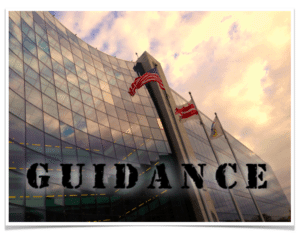Last week, the Securities and Exchange Commission (SEC) moved forward on clarifying their position regarding digital assets. First, a No-Action Letter (NAL) was released pertaining to the issuance of a token by TurnKey Jet. In a tightly defined issuance, Turnkey was deemed not to be a security and thus not under the purview of the SEC.
The same day, the SEC published a “Framework for ‘Investment Contract’ Analysis of Digital Assets.” The Framework outlined some of the factors to be considered in determining when a digital asset may no longer be a security. While greater regulatory clarity is always preferred some industry followers were underwhelmed by the SEC’s guidance. As one industry expert stated with an element of irony, a laundromat token is still a laundromat token.
CI reached out to Doug Ellenoff, Managing Partner of Manhattan-based law firm of Ellenoff, Grossman & Schole. Ellenoff, a well-known securities attorney who has worked closely with the SEC in the past, has long warned about the exuberance associated with initial coin offerings. While embracing innovation, Ellenoff understands all to well the realities of compliance. We asked Ellenoff for his analysis of both the NAL and the Framework. Our conversation is shared below.
The No Action Letter for TurnKey Jet (TKJ) is arguably a No Action Non Event. Doesn’t this really emphasize the fact that any token, that may change in value, is a security?
Doug Ellenoff: While on the surface and certainly within the token economy, I agree with your overall observation that nothing much is new in the NAL but that is largely because I have been of the belief that if a token is being designed to appreciate in value, that under existing securities laws it would be deemed to be a security.
 Logically, except in unusual circumstances, a token would appreciate in value only because the token has inherent economic value due to the decentralized nature of the blockchain business models and thus a security. So no surprise there.
Logically, except in unusual circumstances, a token would appreciate in value only because the token has inherent economic value due to the decentralized nature of the blockchain business models and thus a security. So no surprise there.
The NAL though hasn’t changed my views on the fundamental differences between a Utility Token and a Security, as broadly interpreted by experienced lawyers and regulators under the Howey Test and existing case law. I actually do believe that if a token is likely to change in value, it should be deemed a security.
The NAL does though confirm what seems obvious that a pre-order, advance sale, loyalty arrangement should still remain outside of the jurisdiction of securities laws. Be wary though of the condition that the platform be commercially viable at the time of sale of the tokens. Depending upon how you apply the analysis to non-token facts and circumstances, there could be an argument that the NAL actually suggests that many previously unthought-of activities could now be captured as securities in the reasoned legal analysis of TKJ. It shouldn’t alarm anyone because I believe that the SEC is merely speaking to the token community, but it does raise potential issues inadvertently.
I do not believe that the NAL is the genesis of a new way of conducting a token offering that will be the impetus of many followers. If there are, I fear that they don’t appreciate what the SEC has actually permitted.
I think the guardrails which the SEC has highlighted in TKJ make sense and are generally consistent with where I’d draw the dividing line between what I would have presumed to have been an item with primarily consumptive value (i.e. the Utility Token) as opposed to an instrument for investment/speculation (i.e. a Security).
I would emphasize that an issuer and their counsel ought to read the key elements of TKJ and the Framework carefully and ensure full compliance with ALL and not just a few of the findings.
Furthermore, although it is clear that, as with all NALs, the SEC recognizes that some commercial parties will use this NAL to assess ways around these specific rules and in their views technically comply with the NAL, and thus not be deemed a security, but the lesson of the ill-fated ICOs guides me to further warn the uninitiated that “cleverness” (i.e. too clever by half) in the securities industry will be ultimately challenged with equal to superior “cleverness”.
My advice is simply that in a battle of wits between regulators and “disruptors”, if there are investor losses, particularly retail investor losses, the issuers who embrace this supposed new approach to defeat the TKJ NAL will be found actually to have violated Howey, the NAL, and Framework and will be deemed to be securities. I just know this to be true no matter who believes that they have devised a new business model to evade this basic concept. The reminder is that failure to properly comply with the securities laws has very substantial consequences and shouldn’t be undertaken lightly.
This is not to say that I fully agree with the NAL analysis in TKJ, I don’t.
I actually believe that a Utility Token for a pre-commercially viable entity/product (like Oculus), or post for that matter ought to be permissible under Howey so long as the Utility Token, or advance purchase, may not be resold at all (or if permitted, at cost).
The pre or post-viability argument is more of a practical risk mitigation issue in my view (and worthwhile practically from a regulators perspective—although who is to decide this issue since all platforms continually need more development) and not specifically contemplated in this manner by Howey.
All businesses and technology have continued risk and are subject to obsolescence and failure from inception and well past commercial viability, and so, I tend to agree more with the focus on the secondary tradability, marketing of the tokens/investor expectations and mark-up in value in the NAL.
Even more controversially though I have come to believe (although I encourage any reader to share with me their views to the contrary) that any token issued in a truly decentralized network inherently has both consumptive and investment characteristics (versus a centralized company with an ongoing P&L, the decentralized company has functionally and definitionally distributed and embedded economic value within each token, and therefore, the token will forever be a security as well—which is why founders keep a large chunk of tokens for themselves (as a surrogate for equity).
So why do it? Is this more of a promotional event for TKJ? Is there anything new here beyond providing an explicit statement that utility tokens, exemplified by ICOs, do not exist?
Doug Ellenoff: A legitimate question which I partially address above.
As you are no doubt aware, the SEC doesn’t have to agree to issue a NAL, and typically, only does it when it believes that there is a timely legal issue in question that they want to resolve and message to the public. Your audience needs to appreciate though that a NAL may not be relied upon by any other issuer of tokens. This NAL is only for the benefit of TKJ, although any issuer of tokens must assess their issuance in the context of the analysis and findings in this NAL.
 So while no other issuer may directly rely on this NAL, it is custom and practice for securities lawyers to use the analysis from other NALs for making their own determination of how their clients should proceed in the future, or until additional guidance is provided. In all likelihood, other petitioners will not have their request for a NAL for their specific facts entertained by the SEC but will base their legal analysis in part on the guidance of TKJ.
So while no other issuer may directly rely on this NAL, it is custom and practice for securities lawyers to use the analysis from other NALs for making their own determination of how their clients should proceed in the future, or until additional guidance is provided. In all likelihood, other petitioners will not have their request for a NAL for their specific facts entertained by the SEC but will base their legal analysis in part on the guidance of TKJ.
So why now. Well, out of the ashes of the ICO enforcement actions and settlements, there nonetheless continues to be ongoing interest in tokens generally, STOs, Stablecoins etc. and obtaining some clarity between what the SEC deems to be permissive activity outside the scope of regulators purview.
Interestingly, rather than revisit the issue of whether Howey remains good law or exploring potential clarifications to Howey directly, they have elected to address what in their judgment isn’t a security but specifically limited to the tokenized world.
So while this is certainly excellent marketing for TKJ, the SEC has elected to issue this NAL in my view to further indicate to the token community that they have considered the issue of where to draw the line on where a token begins and end and in particular their focus on secondary tradability/appreciation as a focus of concern.
With the inventory of numerous applications for platforms to be approved as alternative trading systems (ATSs), the SEC has sent a message of some importance of what will be permitted to trade on those exchanges.
Did the “Framework” for digital assets published by the SEC expand the definition of a security when applied to coin offerings?
Doug Ellenoff: As I have consistently maintained on CI, and what may come across as very arbitrary unfortunately, I believe that there is much more to understanding if an activity, scheme or arrangement is a security specifically, and therefore, lawful activity for that matter generally, than just by reading the Howey Test and having a general understanding of what is and isn’t an “investment contract”.
Having participated in the development of a variety of novel alternative finance programs (each of which has involved extensive discussion and interaction with the SEC, FINRA and NASAA) my belief is that reviewing statutes, rules, guidance and now add the so-called Framework, are merely a good start to any required analysis.
Critical to challenging any status quo or disrupting any convention, there must be a considerable amount of thought and sensitivity to the daily concerns of regulators and the magnitude of their responsibilities, if you want to achieve a commercially and socially worthwhile outcome.
Of course, any serious analysis needs to include a thorough reading of the applicable law but it has to be considered with a deeper appreciation of the history of the securities laws, the reason for those protections and how avoidance of those safeguards (i.e. the Spirit of the Law) may have potentially negative consequences to innocent investors who may lose their hard earned money.
Simply assessing the four corners of the Howey Test, dissecting each element and then intentionally seeking to structure around them one by one isn’t clever; it’s simply myopic and expedient.
So to answer the questions directly, to me the Framework doesn’t expand the definition of a security, the definition of a security and how regulators will interpret the elements will inevitably morph, as necessary, to regulate the activity specifically designed to circumvent what the rules where there to protect in the first place—retail investors who had no idea what they were investing in (blockchain, tokens, distributed ledger), with no idea of the associated risks and no limitations on how much could be invested in by any individual investor.
Practitioners who discount these legitimate concerns and are only focused on eliminating regulatory friction will intellectualize their actions and advice at the risk, like ICOs, of being academically right but having caused a major dislocation in the capital markets and putting clients in harm’s way.
The Framework addressed secondary transactions for digital assets. In your opinion, has this Framework shut down any possibility for trading of digital assets that are not securities?
Doug Ellenoff: Realistically, YES and intentionally.
While there are a range of legacy activities where a secondary market has been established and maintained for non-digital assets, I do believe that implicit in the Framework is the notion that any instrument which would trade actively and appreciate is a security. So the reverse is true – for a digital asset to NOT be deemed a security it can’t trade actively AND increase in value.
In effect, if a “utility” token, which is tradable, can exist in the US – Congress must act. Correct?
Doug Ellenoff: Yes, the legislation that you would need to have approved would deem a token (with specific characteristics) not to be a security and it would also have to pre-empt state securities laws as well.
While I fully appreciate that there are token advocates seeking to achieve this type of legislative approval in DC, even in those states that are seeking to be pro-actively token friendly in a similar matter, the actual statutes from what I have seen don’t go as far as simply stating that a token is exempt from securities laws – so it would seem extremely unlikely in my view to gain substantive traction.
The consequences of moving forward would be fundamentally undermining to existing US regulatory enforcement of our securities laws and I don’t think the lesson of ICOs supports that sort of initiative.
Stamps are traded and can change in value over time. There is an active market for sports tickets that change in value and entail speculation. Should they be considered securities?
Doug Ellenoff: This question echoes the concerns that I raised in response to your earlier questions.
I am concerned that the language of the NAL is sufficiently broad that each of the activities that you have identified could (but probably won’t) be captured by the logic in TKJ analysis.
Keep in mind though, there are real use case differences in those examples and an entrepreneur seeking to raise funds to commence a new business model, which is the actual jurisdictional purpose of securities regulators.
It would seem to me that the SEC is merely trying to bring order and understanding back to the capital markets for those that abused their gatekeeper responsibilities throughout the ICO era and not to expand their original mandate.




